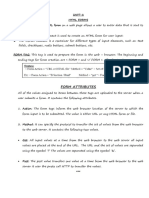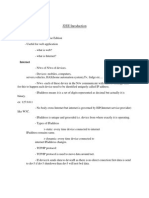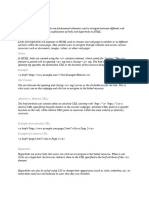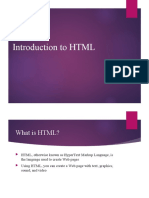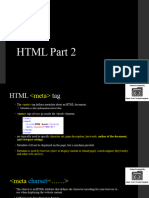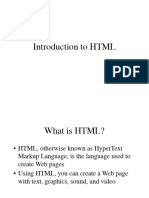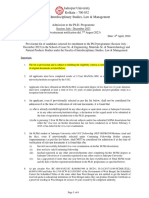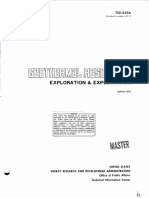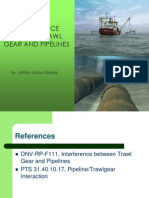0% found this document useful (0 votes)
52 views6 pagesHTML Links, Forms, and Media Guide
The document discusses various HTML tags and attributes used for links, images, forms, and media elements. It describes the <a> tag and href and target attributes used to create hyperlinks. It also explains the <img> tag and its attributes like src, alt, width, and height. For forms, it covers the <form>, <label>, <input>, <select>, <textarea>, <button>, and <datalist> tags along with their attributes. It provides examples of how to create text fields, radio buttons, checkboxes, dropdowns, textareas, and buttons. It also discusses the <video> and <audio> tags used to embed media with the src and type attributes.
Uploaded by
Gamit MayankCopyright
© © All Rights Reserved
We take content rights seriously. If you suspect this is your content, claim it here.
Available Formats
Download as PDF, TXT or read online on Scribd
0% found this document useful (0 votes)
52 views6 pagesHTML Links, Forms, and Media Guide
The document discusses various HTML tags and attributes used for links, images, forms, and media elements. It describes the <a> tag and href and target attributes used to create hyperlinks. It also explains the <img> tag and its attributes like src, alt, width, and height. For forms, it covers the <form>, <label>, <input>, <select>, <textarea>, <button>, and <datalist> tags along with their attributes. It provides examples of how to create text fields, radio buttons, checkboxes, dropdowns, textareas, and buttons. It also discusses the <video> and <audio> tags used to embed media with the src and type attributes.
Uploaded by
Gamit MayankCopyright
© © All Rights Reserved
We take content rights seriously. If you suspect this is your content, claim it here.
Available Formats
Download as PDF, TXT or read online on Scribd
/ 6



